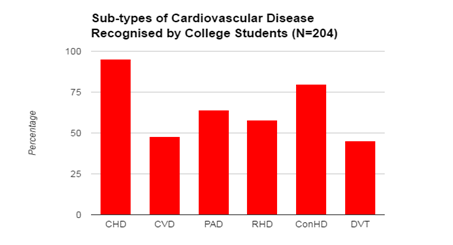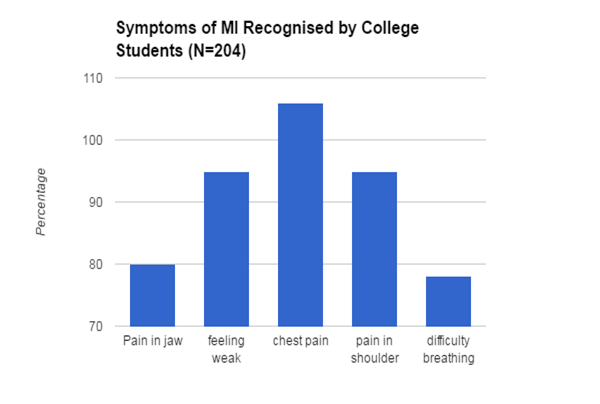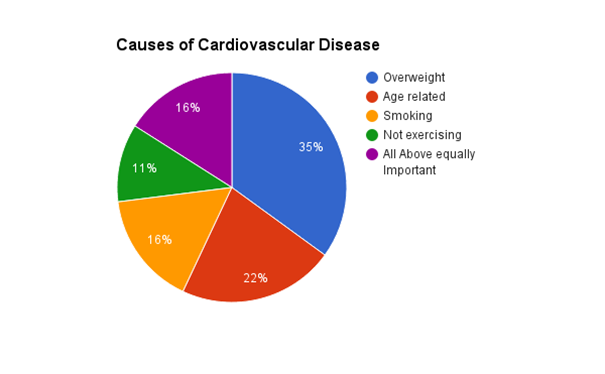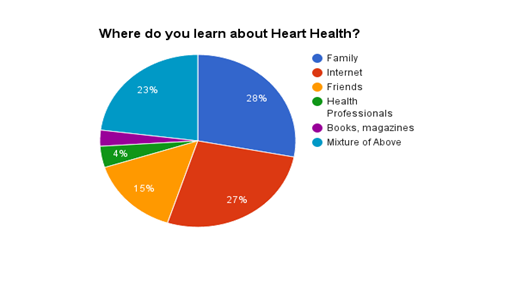Assessing the Knowledge of Cardiovascular Disease Among Young People in South Dublin
Article Information
Liam O’Halloran*, Molly Slattery
Department of Medicine and Medical Sciences, University College Dublin, Belfield, Dublin, Ireland
*Corresponding Author: Liam O’Halloran, Department of Medicine and Medical Sciences, University College Dublin, Belfield, Dublin, Ireland
Received: 09 August 2017; Accepted: 18 August 2017; Published: 21 August 2017
View / Download Pdf Share at FacebookAbstract
Introduction: Cardiovascular diseases cause approximately 46% of total deaths in Ireland. These conditions can be preventable with lifestyle changes. By 2020 the number of deaths is expected to rise to over 195,000 people. With the aim, to develop teaching programs about CVD, it is important to assess young peoples' understanding of CVD.
Methods: This was a cross-sectional questionnaire-based research study conducted in seven pharmacies in south Dublin. Customers aged between 18-30 were requested to take part in the study. Descriptive and variable provision multivariate analysis was used in information analysis.
Results: The least recognized symptom of a myocardial infarction was dyspnea (69%). The least recognized symptom of stroke was headache (65%). In terms of where young people obtain health information, 66% learned from doctors, while family members and the internet were the main source in 18% and 17%. 35% of young people believed weight was the most factor that increased your risk of cardiovascular disease while 22% believed smoking was most important.
Discussion: There was deficiencies in cardiovascular disease knowledge among young people, especially related to MI/Stroke.
Keywords
Cardiovascular diseases; Myocardial infarction; Stroke
Article Details
1. Introduction
Cardiovascular diseases (CVDs) are a group of disorders involving the heart and blood vessels [1]. They include a range or related conditions including; coronary cardiovascular disease (CHD), vessel disease, rheumatic cardiovascular disease, congenital heart disease, deep vein thrombosis and other related conditions [2]. CVD is the leading cause of deaths in developed and developing countries. In 2008, 30% (17.5 million people) of all-cause deaths were from CVDs. It is anticipated to rise to 23.3 million by 2030 [3]. Cardiovascular disease (CVD) is one of the most modifiable causes of death in the world, due to the fact risk factors are controllable; hypertension, diabetes, obesity, smoking, and diabetes.
The social and environmental causes of CHD and stroke have been identified, and educational population-based prevention programs could result in a significant decrease in CVD morbidity and mortality [4]. Knowledge about CVD and its modifiable risk factors is a vital prerequisite to change a patient's health attitudes, behaviours and lifestyle. An understanding of the knowledge of CVD among young people and the sources they use for information would enable the development of effective programs.
2. Methods
A descriptive, cross-sectional survey was undertaken in a small community pharmacy in a south Dublin Ireland with an estimated population of 265,350 people [5]. The survey was undertaken during the period from January 2014 to July 2016. Ethical Approval was obtained from the Royal College of Surgeons In Ireland. Customers aged from 18-30 attending the pharmacy were requested to take part in the study. Customers were given the questionnaires, which were completed anonymously and returned to the pharmacy after completion. Data was then inserted into a data-book. Data was stored in the pharmacy controlled drug safe for use by the study researchers only. Exclusion criteria were ages less than 17 or above 30 years and health care professionals.
A literature review of previous studies regarding CVD knowledge was conducted to identify potential terms for the questionnaire. Based on the literature search, the study questionnaire was adapted from previous studies used in Australia, North Ireland and Canada [6-12]. The questionnaire consisted of four main sections. The first section included ten items to provide information about the sociodemographic.
Section two consisted of four questions treated to the customer's health status including; presence of chronic diseases, medications, body mass index, cholesterol and blood glucose. The third section included three questions to determine the knowledge with regard to six types of CVD, five myocardial infarction symptoms, six stroke warning symptoms, and seven CVD risk factors. Section four included two questions to understand the young person’s view on the role of pharmacists in CVD management.
A scoring system was applied to measure the respondents' knowledge. Knowledge scores were categorized for each section as low [2], moderate [3,4] and high [5]. Customers were also asked where they obtained most of their health information, whether from doctors, family, friends, media sources or other health professionals. Univariate logistic regression was performed to determine the relationship of each independent variable with the overall knowledge of CVD. All variables with p <0.25 in the univariate analysis were used in the multiple logistic regression analysis to determine the factors that are associated with CVD knowledge.
Statistical significance was accepted at p <0.05 Data were entered into the Statistical Package for Social Sciences (SPSS, version 22, SPSS, Chicago, IL, U.S.A.) and descriptive analysis was conducted.
3. Results
A total of 112 patients aged between 18 and 30 were invited to take part in the study which was advertised in the pharmacy. Their median age was 28 years. Of the respondents, 63 patients (57%) were females, and 69 patients (62%) had a college degree while 20 patients (18%) were pursuing a degree. In total only 10 patients (9%) indicated that they currently smoked 32 patients (29%) were ex-smokers, 79 patients (71%) indicated that they used to exercise at least two times per week. 79 patients (71%) reported eating healthy food every day.
15 patients (14%) reported to have a stress-free lifestyle, 65 patients (58%) relatively stressful lifestyle and 31 patients (28%) very stressful. Only 31 patients (28%) had a first-degree relative with cardiovascular disease. Of the study population, only 15 patients (13.5%) reported that they had a recent (<12 months) measure of their blood pressure.
Overall the knowledge of cardiovascular disease was good, with 85% recognizing that coronary heart disease was a type of cardiovascular disease. The least recognized subtypes included cerebrovascular disease where only 48 patients (43%) considered it a subtype of CVD and DVT where the number was 44 patients (40%). In the univariate analysis, factors significantly associated with CVD knowledge included gender, age, education, and family history of CVD (p <0.05).
The knowledge about CVD was significantly greater among females compared to males (p= 0.022). The study participants were found to be more knowledgeable about CVD if they reported attending high education (p= 0.036), eating a healthy diet everyday (p <0.02), and having a family history of CVD (p <0.02).
The most commonly recognized symptom of a myocardial infarction was chest pain 102 patients (95%). Other commonly recognized symptoms include feeling weak 97 patients (87%) and having a pain in the shoulder or arm 94 patients (84%). The least recognized symptoms were that of difficulty breathing at only 77 patients (69%).
Of note there was a correlation between education level and knowledge, those with a college degree were 1.43 times more likely to recognize symptoms associated with stroke or MI (P=<0.05) (CI= 0.36-0.68).
When looking at causes of cardiovascular disease, only 71 patients (35%) felt being overweight was a cause of heart disease, Age was seen as important in 45 patients (22%) while of note, smoking was seen as a contributor to cardiovascular disease in 32 patients (16%).
Young people learned about cardiovascular disease from various sources, the internet and family being the most important. 20 patients (18%) obtained health education primarily from their family while 19 patients (17%) used internet sources as their main source. Only 6 patients (5%) obtained most of their information from friends, 5 patients (4%) from allied health professionals. Those without a college degree were 1.34 more likely to get information from their friends (CI=0.44-0.56) (P=<0.05) and 1.64 from other health professionals (CI 0.34-0.78) (P=<0.05).
4. Discussion
This study has highlighted the knowledge gap in cardiovascular disease for the ages of 20-30 years. Excluding CHD which was recognized by 95 patients (85%) as a cardiovascular disease, approximately 32 patients (29%) of the study population were not aware of any other type of CVD. 17 patients (15%) were not aware of any other MI symptom apart from chest pain.
Chest pain was the most common known symptom 106 patients (95%) and shortness of breath by 87 patients (78%), which is higher than previous studies from North Ireland, Canada, Iran and Jordan [13-17]. Knowledge of stroke was much better with 100 patients (90%) able to name three or more symptoms of stroke most commonly weakness in the face (95%), trouble speaking (90%) and dizziness (90%). These figures were 10-20% higher than studies in Australia, Canada and the Gulf countries [9-12], but ~5% lower than that in the USA [18-20]. Factors independently associated with CVD knowledge. In the current survey, age, level of education, eating a healthy diet, and family history of CVD were found to be significantly associated with CVD knowledge (p <0.05).
71 patients (35%) felt being overweight was a cause of heart disease, Age was important in 45 patients (22%) while of note, smoking was seen as a contributor to cardiovascular disease in 32 patients (16%). This seems to indicate that young people do not understand the risk factors for heart disease or perceive that they are not at risk of cardiovascular disease considering that a large proportion felt that age was the most important risk factor.
Knowledge about CVD was significantly raised among females compared to males, which is an agreement with a previous study conducted in Iran and Korea [21-23]. 43 patients (38%) obtained health education primarily from their family while 30 patients (27%) used internet sources as their main source. Notably, only 17 patients (15%) obtained most of their information from friends, 9 patients (8%) from other health professionals.
This research highlights the importance of developing high quality education resources online for young people and their families to ensure positive health choices are made. Such educational resource should focus on helping young people understand the risk factors and types of cardiovascular disease.
References
- Balanda KP, Barron S, Fahy L. Making Chronic Conditions Count: Hypertension, Coronary Heart Disease, Stroke, Diabetes. A systematic approach to estimating and forecasting population prevalence on the island of Ireland. Executive Summary Dublin: Institute of Public Health, 2010.
- World Health Organization:Cardiovascular diseases.http://www.euro.who.int/en/health-topics/noncommunicable-diseases/cardiovascular-diseases/cardiovascular-diseases2/definition-of-cardiovascular-diseases. World Health Organization:Cardiovascular diseases (CVDs): Fact sheet No. 317.http://www.who.int/mediacentre/factsheets/fs317/en/.
- Morgan K, McGee H, Watson D, Perry I, Barry M, Shelley E. SLÁN 2007: Survey of Lifestyle, Attitudes & Nutrition in Ireland. Main Report Dublin: Department of Health and Children, 2008.
- Walsh, K. & Nic Gabhainn, S. (2004). Drunkenness among Irish schoolchildren. Health Behaviour in School-Aged Children Survey [online]. Available: http://www.nuigalway.ie/hbsc/factsheets.html
- Layte R, McCrory C. National Longitudinal Study of Children. Overweight and Obesity in nine year olds, 2011.
- Barrett A, Savva G, Timonen V, Kenny RA. Fifty Plus in Ireland 2011 First results from the Irish Longitudinal Study on Ageing (TILDA), 2011.
- Becker MH, Maiman LA, Kirscht JP, Haefner DP, Drachman RH. The Health Belief Model and prediction of dietary compliance: a field experiment. J Health Soc Behav 18 (1977): 348-366.
- Ford ES, Jones DH. Cardiovascular health knowledge in the United States: findings from the National Health Interview Survey, 1985. Prev Med 20 (1991): 725-736.
- Haque IU. Cardiovascular health knowledge and behavior in patient attendants at four tertiary care hospitals in Pakistan?a cause for concern. BMC Public Health 5 (2005): 124.
- Sug Yoon S, Heller RF, Levi C, Wiggers J, Fitzgerald PE: Knowledge of stroke risk factors, warning symptoms, and treatment among an Australian urban population. Stroke 32 (2001): 1926-1930.
- Jafary FH, Aslam F, Mahmud H, Waheed A, Shakir M, et al. Cardiovascular health knowledge and behavior in patient attendants at four tertiary care hospitals in Pakistan?a cause for concern. BMC Public Health 5 (2005): 124.
- Perk J, De Backer G, Gohlke H, Graham I, Reiner Z, et al. European Guidelines on cardiovascular disease prevention in clinical practice (version 2012). The Fifth Joint Task Force of the European Society of Cardiology and Other Societies on Cardiovascular Disease Prevention in Clinical Practice (constituted by representatives of nine societies and by invited experts). Eur J Prev Cardiol 19 (2012): 585-667.
- Al Hamarneh YN, Crealey GE, McElnay JC. Coronary heart disease: health knowledge and behaviour. Int J Clin Pharm 33 (2011): 111-123.
- Gill R, Chow CM. Knowledge of heart disease and stroke among cardiology inpatients and outpatients in a Canadian inner-city urban hospital. Can J Cardiol 26 (2010): 537-540.
- Mukattash TL, Shara M, Jarab AS, Al-Azzam SI, Almaaytah A, et al. Public knowledge and awareness of cardiovascular disease and its risk factors: a cross-sectional study of 1000 Jordanians. Int J Pharm Pract 20 (2012): 367-376.
- Awad A, Al-Nafisi H. Public knowledge of cardiovascular disease and its risk factors in Kuwait: a cross-sectional survey. BMC Public Health 14 (2014): 1131.
- Reeves MJ, Rafferty AP, Aranha AA, Theisen V. Changes in knowledge of stroke risk factors and warning signs among Michigan adults. Cerebrovasc Dis 25 (2008): 385-391.
- Attarchi M, Mohammadi S, Nojomi M, Labbafinejad Y. Knowledge and practice assessment of workers in a pharmaceutical company about prevention of coronary artery disease. Acta Med Iran 50 (2012): 697-703.
- Margolis KL, Asche SE, Bergdall AR, Dehmer SP, Groen SE, et al. A Randomized Trial of the Effect of Pharmacist Prescribing on Improving Blood Pressure in the Community: The Alberta Clinical Trial in Optimizing Hypertension (RxACTION) 10, 2015.
- Green BB, Cook AJ, Ralston JD. Effectiveness of home blood pressure monitoring, Web communication, and pharmacist care on hypertension control: a randomized controlled trial. JAMA 299 (2008): 2857-2867.
- Timmer SG, Eccles JS & O’Brien K (1985). How children use time. In F. T. Juster & F. P. Stafford (Eds.), Time, goods and well-being (pp. 353-369). Ann Arbor, Michigan: Institute for Social Research.
- Knowledge of Stroke and Heart Attack symptoms and risk factors among rural people: A questionnaire survey. The Korean Society of Cardiology 2001.
- L Potvin,L Richard. Knowledge of cardiovascular disease risk factors among the Canadian population: relationships with indicators of socioeconomic status CMAJ 162 (2000): S5?S11.




